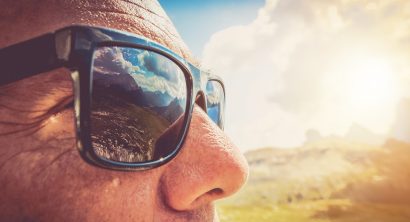Summer is Here – Protect Yourself Against Eyelid Skin Cancer
Written by Dr. David Evans Last modified on August 6, 2018
Living in a beach community like San Diego, protecting yourself from the sun is a way of life. While this is important year round, it becomes even more important during summer. But as good as we San Diegans are at making sure to load up on high SPF sunscreen to protect our skin before hitting the beach, many are unaware about the importance of protecting our eyes. And the same can be said about most people.
Sun exposure can damage your eyes in a number of different ways, including increasing your risk for macular degeneration and cataracts. These are serious eye conditions that can threaten your vision; but not your life. Skin cancer on the other hand can put you at risk of both.

According to the Skin Cancer Foundation, one in every five Americans will get skin cancer at some point in their life. The most common types of skin cancer include basal cell cancer (BCC), squamous cell skin carcinoma (SCC) and melanoma — the most dangerous of all skin cancers. It’s estimated that as much as 10 percent of all skin cancer cases will affect the eyelid.
Fortunately, the vast majority of these cases are not of the melanoma variety (Less than 5 percent according to the Skin Cancer Foundation).
The eyelid is one of the most common locations for non-melanoma skin cancer to develop. Although BCC and SCC may not be as likely to metastasize to the lymph nodes as melanoma, they are nonetheless serious and could potentially damage your eyes. There are various surgeries that can successfully remove eyelid tumors, with Mohs’ surgery typically chosen as the preferred option. But keep in mind that even a successful surgery could have vision-health consequences. For example, the surgery may impact tear drainage which can increase your risk of chronic dry eye or a host of other eye problems. In the worst case scenario, removal of the eye itself may even need to be considered. As is the case for any cancer treatment, early detection is KEY. And prevention is KING.
So what can you do? Fortunately, it’s pretty easy. Make sure that you apply sunscreen to every part of your body, including your eyelids, at risk of sun exposure (at least SPF 15). And wear sunglasses that offer 99 percent UV-protection or better anytime you spend a significant time outdoors. This is particularly important for children who tend to spend far more time outdoors than adults. And many of them don’t wear sunglasses, hats or sunscreen to give them the protection they need. Even if it seems a bit overcast, the sun’s UV rays can still put you and your children at risk.
Tanning beds are risky business due to the high amount of UV radiation they expose the body to. But if you aren’t willing to give up that golden tan, it’s an absolute imperative that you protect your eyes appropriately with UV-protection goggles and SPF on your eyelid skin.
You should also get regular skin cancer screenings from your doctor or dermatologist. Sunscreen and sunglasses help protect you, but they are not 100 percent effective.
To learn more about eyelid cancer and how you can protect yourself and your loved ones this summer, check out www.skincancer.org
